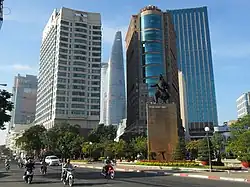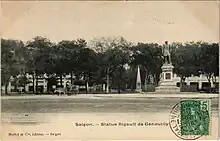Mê Linh Square
Mê Linh Square (Vietnamese: Công trường Mê Linh) is a city square next to the Saigon River in District 1, downtown Ho Chi Minh City, Vietnam. The square has a semi-circular shape and features a statue of Trần Hưng Đạo, it is separated from the Saigon River by the Bạch Đằng Quay.[1][2]
Mê Linh Square
Công trường Mê Linh | |
|---|---|
| City square | |
| Former name(s): Place Rigault de Genouilly | |
 Me Linh Square in 2012 | |
| Completion | 1962 |
| Owner | Ho Chi Minh City |
| Location | District 1, Ho Chi Minh City |
| Coordinates: 10°46′31″N 106°42′23″E | |
History
Prior to the square's original layout in 1863, its site was the junction of the quayside street and a historic road of Saigon that once ran through the old citadel (the Thành Quy). According to scholar Vuong Hong Sen, the wharf opposite of the square was where the French naval ships anchored to capture Saigon in 1859.[3]: 60, 73
Initially known as the "Rond-point", the square was planned to serve as a central point for the European city that was going to be built.[4]: 497 By 1871, four other streets radiating from the square: rue Vannier, rue Turc, rue de Thu-Dau-Mot and rue de Yokohama (modern-day Ngô Đức Kế, Hồ Huấn Nghiệp, Thi Sách and Phan Văn Đạt, respectively) had also been opened, giving the area its present road layout.[5]


On 17 February 1879, the occasion of the 20th anniversary of the capture of Saigon, the authorities inaugurated a bronze statue of Admiral Charles Rigault de Genouilly (1807–1873) by sculptor Alexandre-Victor Lequien (1822–1905) on the roundabout.[6][7] This statue stood on a granite pedestal and was fenced off with golden-pointed railings, the Rond-point was henceforth known as place Rigault de Genouilly. The semi-circular open space of the square, in addition to the central roundabout where the Rigault de Genouilly statue stood, consisted of three surrounding gardens with two pyramid-shaped monuments placed on two of the three gardens.[8] The first monument in the middle garden was relocated from its original position on the riverside at the end of rue Catinat.[3]: 118 Its base read: « À Lamaille , le commerce saïgonnais reconnaissant » (translating to "To Lamaille with gratitude, Saigon merchants").[4]: 511 The second monument in the left garden was a memorial to Ernest Doudart de Lagrée (1823–1868), the naval officer and explorer who died in Yunnan in 1868 while leading the Mekong expedition. And just like the first monument, this one was reerrected. It was first erected on boulevard Charner, shortly after the Grand Canal was filled in. In 1890, it was relocated to boulevard Bonard but only stood there for a few years. Then in 1895, to make space for the Municipal Theatre, it was again relocated to place Rigault de Genouilly.[4]: 503 Additionally, in 1891, the terminus of the steam tramway line from Saigon to Cholon was installed on the quayside opposite the square.[5]
.jpg.webp)
Following the August Revolution in 1945, the Rigault de Genouilly statue was abducted and scholar Vuong Hong Sen revealed that it was later melted down.[3]: 73 In 1955, place Rigault de Genouilly was renamed Mê Linh Square by the South Vietnamese government, after the two Trưng sisters' home prefecture. In March 1962, Madame Nhu, as the head of the newly-started Women's Solidarity Movement, erected a statue of the Trưng sisters at the square's center. The statue, cast by sculptor Nguyễn Văn Thế, portrayed the two sisters on a large three-legged pedestal, with one leg resembling an elephant trunk and the other two resembling the animal's legs.[9] Mê Linh Square was also renovated with a pond added. However, the Trưng sisters' faces and figures were said to resemble Madame Nhu herself, and people started to rumor that she had asked for the statue to be modeled after her own facial features.[10][11]: 125–126 Consequently, after the coup d'état in November 1963, the anti-government crowd tore down the statue and rolled the broken-off head through the streets.[11]: 206 The pedestal was then left empty until 1967, when the current statue of Trần Hưng Đạo, commissioned by the Republic of Vietnam Navy and cast by sculptor Phạm Thông, occupied the spot.[12] During the third Mongol invasion of Đại Việt, Trần Hưng Đạo was the commander of the naval battle on the Bạch Đằng River which resulted in Đại Việt's victory, and thus the South Vietnamese Navy chose him as their patron saint.[13][14] The statue depicts Trần Hưng Đạo standing with his left hand holding a sword and his right hand pointing across the Saigon River.[12]
See also
References
- "Map of Ho Chi Minh City". HCM CityWeb.
- "Me Linh Square". Lonely Planet.
- Vương, Hồng Sển (1969). Sài Gòn năm xưa (in Vietnamese). Nhà sách Khai Trí.
- Baudrit, André (1943). Guide historique des rues de Saigon. Saigon: S.I.L.I.
- Doling, Tim (25 May 2017). "Saigon's Famous Streets and Squares: Me Linh Square". Saigoneer.
- "Bibliographie de l'Indochine orientale depuis 1880". Bulletin de la Societe des etudes indo-chinoises de Saigon: 41. 1889.
- Madrolle, Claudius (1926). Indochine du Sud. De Marseille à Saïgon ; Djibouti, Ethiopie, Ceylan, Malaisie, Cochinchine, Cambodge, Bas-Laos, Sud-Annam, Siam. Cartes et plans. Paris: Librairie Hachette. p. 10.
- Nguyễn, Khắc Viện; Ngọc, Hữu (1998). From Saigon to Ho Chi Minh City: a path of 300 years. Thế Giới Publishers. pp. 313–314.
- Trung Hiếu (November 29, 2015). "Từ tượng Hai Bà đến tượng Trần Hưng Đạo 'trấn giữ' Bạch Đằng". Thanh Niên (in Vietnamese).
- Tran, Nhung Tuyet (September 3, 2021). "These elephant-riding warrior sisters freed ancient Vietnam from Chinese rule". National Geographic.
- Demery, Monique Brinson (2013). Finding the Dragon Lady: The Mystery of Vietnam's Madame Nhu. PublicAffairs.
- Nguyễn, Minh Hòa (November 5, 2021). "Tôn tạo tượng Đức Thánh Trần và công viên Mê Linh: Cần một tâm thế mới". Người Đô Thị (in Vietnamese).
- "Pres. Thieu presides over Vietnamese Navy Day". Vietnam Bulletin. 4 (31): 1. October 5, 1970.
- Vu, Hao-Nhien (August 17, 2015). "Bolsavik: Why Vietnamese Gen. Tran Hung Dao is Headed to Mile Square Park". Voice of OC.
External links
 Media related to Mê Linh Square at Wikimedia Commons
Media related to Mê Linh Square at Wikimedia Commons